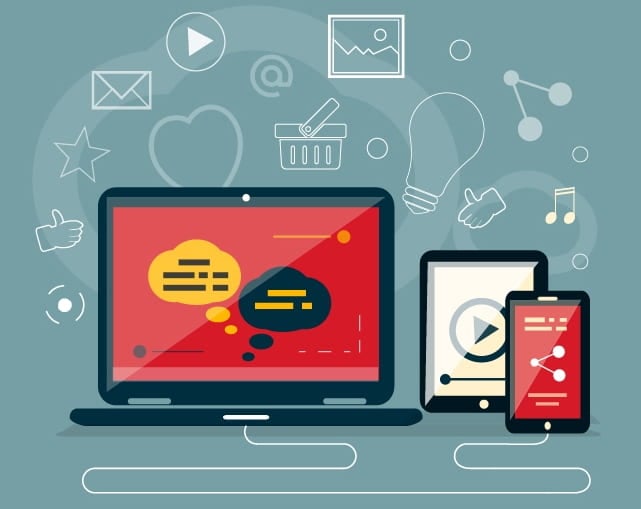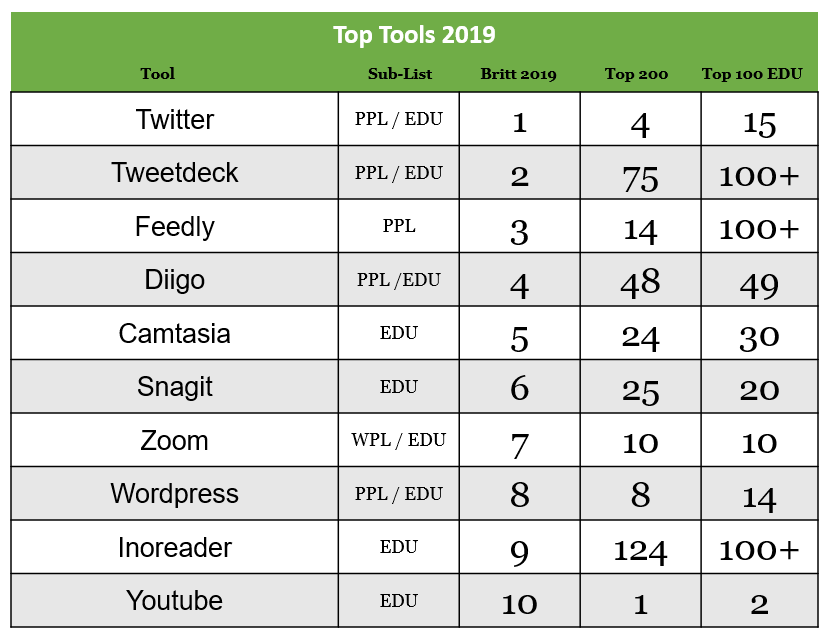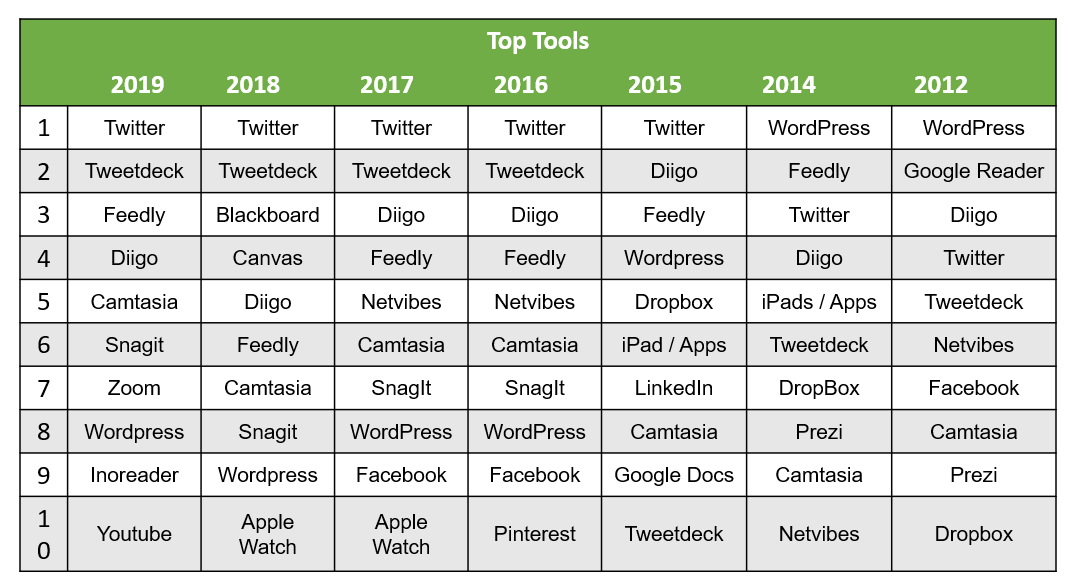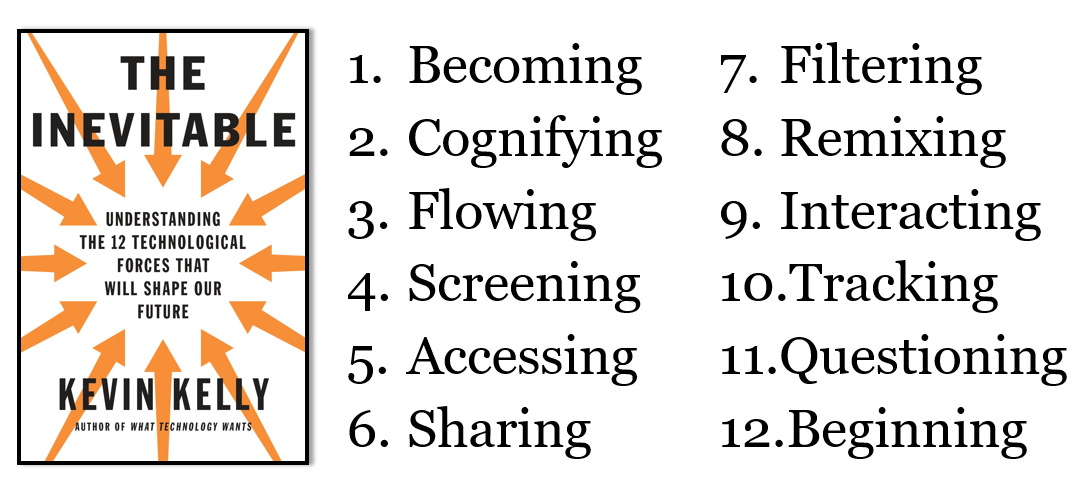For the 13th year, voting for the Top Tools for Learning is open (closing September 13th). I have participated in Jane Hart’s annual survey for a number of years, and her call for voting for favorite tools is a good opportunity for reflection as well. My last reflection was here.
My top tools this year…and how they align with last year’s rankings…are:
Some tools that I routinely use are for both personal learning and my teaching, while others are more single purpose. Since I work in education, I did not differentiate “workplace” except once…as Zoom is used extensively by Creighton University for professional development. Jane Hart noted this overlap in her analysis last year.
Looking at this year versus previous years, there are some changes…but not a lot:
I still use both Blackboard and Canvas as my teaching LMS platforms, but dropped them from my top ten tools to focus on other tools. The same applies to Apple Watch. All three are used daily…but I consider them more background (like my desktop, laptop, tablets, and browsers).
So, it is interesting (at least to me) that for the past six years, Twitter, Tweetdeck, Feedly, Diigo, Camtasia, and Woodpress (6 out of 10) have consistently been in my top ten. I added Zoom and Youtube because they rank high in last year’s list and I recognize that I use them quite frequently. They also align with Mary Meeker’s Internet Trends report of the increased use of video over text in learning…as well as the increased use of mobile for learning. And I added Inoreader, as I shifted my doctoral course blog aggregation from Netvibes to Inoreader in the past year, and like how it embeds nicely with Canvas.
I mentioned that my desktop, laptop, and tablet are in the background, but another reflection is the fact that I have not replaced any of them in several years. Twenty years ago, it seemed that one was replacing their desktop every couple of years due to the amazing growth of capability in home computers. I went through IBM 286 – 386 – 486 – Pentium – Pentium II all in a single decade…a lot of money given my pay! I currently use a Dell Inspiron 3650 desktop with Intel i5 processor and dual monitors – all four years old and working fine. My laptop is a 2014 MacBook Air…and again, I have no need to replace it. I bought my iPad the same time as my laptop. There has been news about Moore’s Law slowing down … and maybe that is playing out here.
Moving forward, it is interesting to think about how my graduate teaching will align with some of the megatrends we see emerging about the future of work and the future of higher education. Jane noted that:
- More and more people are learning for themselves – in whatever way that suits them best – whether it is finding resources or online courses on the Web or interacting with their professional network. And they do all this for a variety of reasons: to solve problems, self-improve and prepare themselves for the future, etc.
- Learning at work is becoming more personal and continuous in that it is a key part of many professional’s working day. And what’s more people are not only organising their own learning activities, they are also indeed managing their own development too – either with (informal) digital notebooks, or with (formal) personal learning platforms.
- But it is in team collaboration where most of their daily learning takes place, and many now recognize and value the social collaboration platforms that underpin their daily interactions with colleagues as part of their daily work.
These trends – people learning for themselves, learning at work, and learning in teams – all have implications for higher education curriculums. I blogged about the recent Holon Report on Education in 2030, which suggested that learning models and curriculum need to adapt to the evolving top skills, abilities, and knowledge needed by the future workforce. Many of these skills are “soft” skills…yet technology can enhance how these skills are developed.
So, in some ways, this annual look at tools suggest that I am “business as usual.” Yet, the world feels like it is moving in new and unknown directions. The overlap between the future of work, the future of education, and the future of technology continue to drive my thinking.
I have been using Kevin Kelly’s (2016) The Inevitable: Understanding the 12 Technological Forces that will shape our future as my textbook for my Creighton Leadership and Technology course (ILD-831). In many ways, this “future” is already here. That makes me question whether my choice of tools continues to align with this future?
As always, wondering your thoughts. Add to Jane Hart’s database by participating in her survey…and comment here on your thoughts and pushback.
{Graphics: Watwood, Jane Hart, HolonIQ}





